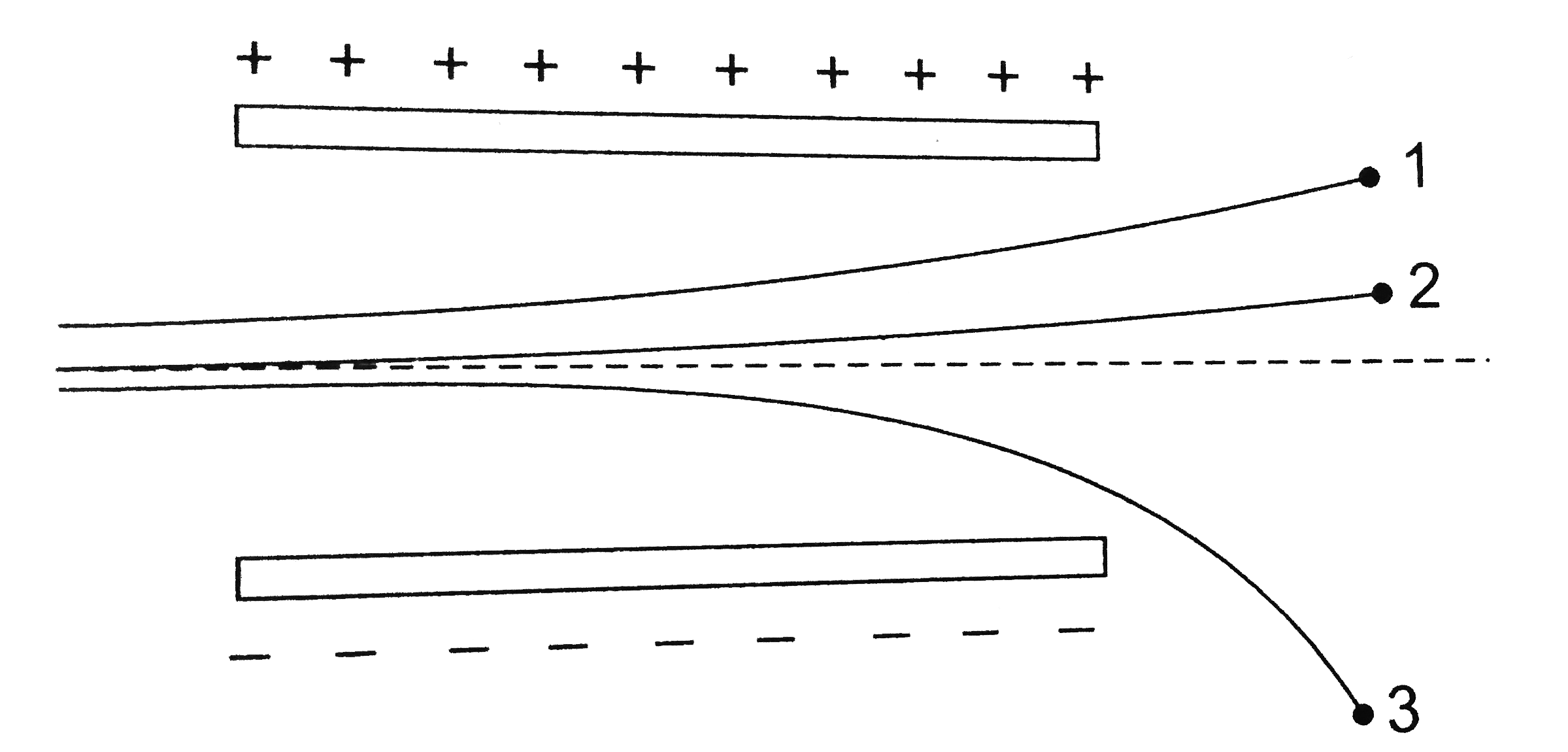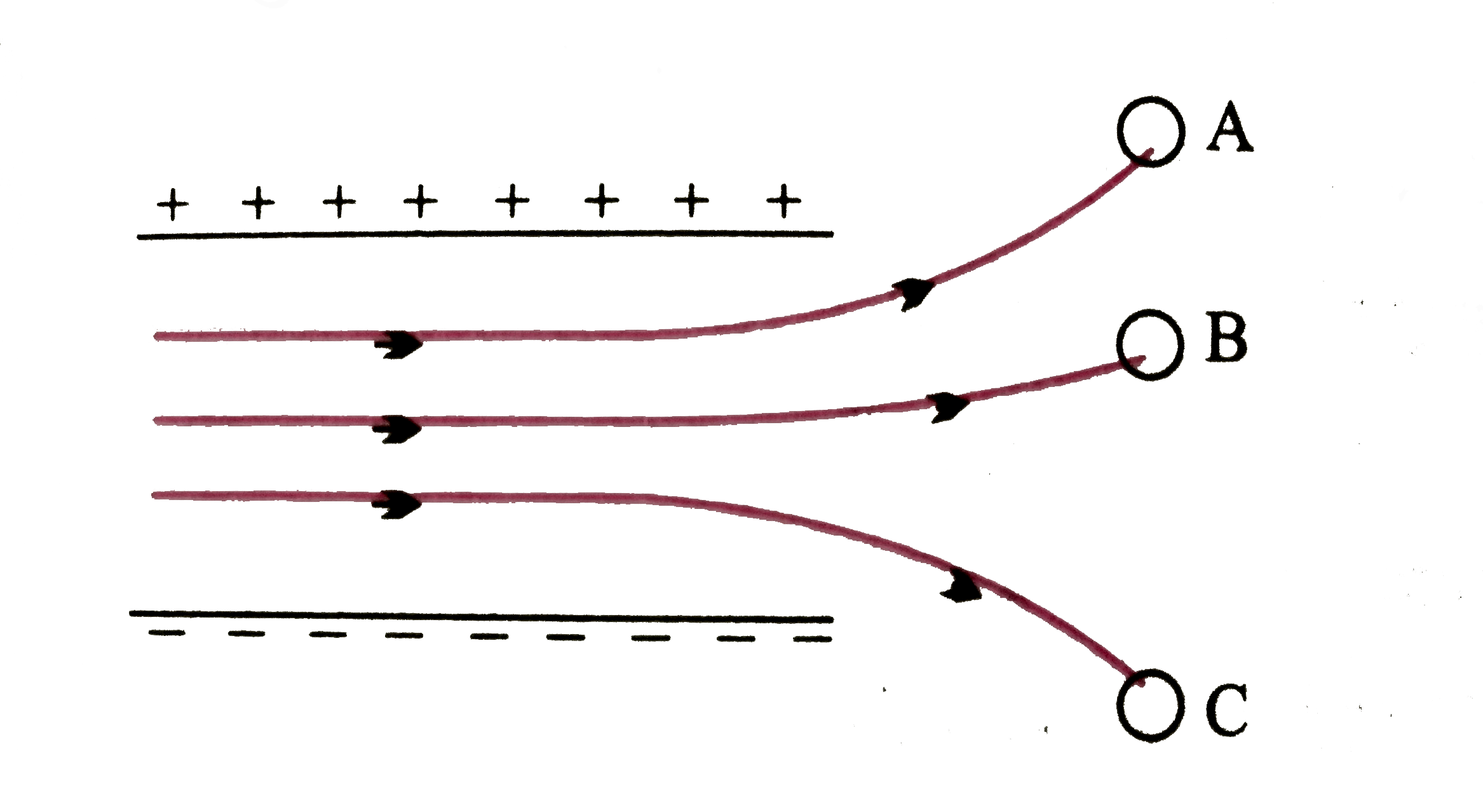Figure shows tracks of three charged particles crossing a uniform electrostatic field with same velocities along horizontal. Give the sign of the three charges. Which particle has the highest charge to mass ratio?

1
2
3
1 and 2
The correct Answer is:C
Particles A and B have negative charges because they are being deflected towards the positive plate of the electrostatic field. Particle C has positive charge because it is being deflected towards the negative plate.
∴ Deflection of charged particle in time t in y-direction
h=0×t+12at2=12qEmt2 i.e.,h∝q/m
As the particle C suffers maximum deflection in y-direction, so it has highest charge to mass q/m ratio.
Topper's Solved these Questions
- ELECTRIC CHARGES AND FIELDSBook:NCERT FINGERTPS ENGLISHChapter:ELECTRIC CHARGES AND FIELDSExercise:Electric Field Lines
Explore 12 Videos
- ELECTRIC CHARGES AND FIELDSBook:NCERT FINGERTPS ENGLISHChapter:ELECTRIC CHARGES AND FIELDSExercise:Electric Flux
Explore 5 Videos
- ELECTRIC CHARGES AND FIELDSBook:NCERT FINGERTPS ENGLISHChapter:ELECTRIC CHARGES AND FIELDSExercise:Force Between Multiple Charges
Explore 5 Videos
- DUAL NATURE OF RADIATION AND MATTER Book:NCERT FINGERTPS ENGLISHChapter:DUAL NATURE OF RADIATION AND MATTER Exercise:Assertion And Reason
Explore 15 Videos
- ELECTROMAGNETIC INDUCTIONBook:NCERT FINGERTPS ENGLISHChapter:ELECTROMAGNETIC INDUCTIONExercise:NCERT Exemplar
Explore 6 Videos
Similar Questions
Electric field lines provide information about
View SolutionThe SI unit of electric flux is
View SolutionTwo charges q and −3q are placed fixed on x-axis separated by distance d. Where should a third charge 2q be placed such that it will not experience any force ?
View SolutionAssertion : Millikan's experiment established that electric charge is quantised.
Reason : From this experiment mass of the electron could not be determined.
View SolutionA square of side L meters lies in the xy-plane in a region, where the magnetic field is given by =B0(2ˆi+3ˆj+4ˆk)T,, where B0 is constant. The magnitude of flux passing through the square is
View SolutionFigure shows the tracks of three charged particles in a unform electrostatic field projected parallel to a plate with the same velocity. Give the signs of the three charges. Which of the three charges. Which of the three particles has the highest charge-to-mass ratio?
View SolutionFigure shows tracks of three charged particles crossing a uniform electrostatic field with same velocities along horizontal. Give the sign of the three charges. Which particle has the highest charge to mass ratio?

View SolutionFigure shows tracks of three charged particles crossing a uniform electrostatic field with same velocities along horizontal. Give the sign of the three charges. Which particle has the highest charge to mass ratio?

View Solutionचित्र में A B और C तीन आवेशित कण दिखाये गये हैं जो एकसमान विद्युत - क्षेत्र में गति करते हैं। तीनों आवेशों के चिन्ह बताइये । किस कण का आवेश और द्रव्यमान का अनुपात अधिक है?

View SolutionFigure shows tracks of three charged particles in a uniform electrostatic field. Give the signs of the three charges. Which particle has the highest charge to mass ratio?
View SolutionFigure below shows tracks of three charged particles in a uniform clectrostatic field. Give the signs of the three charges. Which partiele has the highest charge to mass ratio?
View SolutionTrack of three charged particles in a uniform electroastatic field give the sign of the three charges which particle has the highest charge to mass ratio

View SolutionTrack of three charged particles in a uniform electroastatic field give the sign of the three charges which particle has the highest charge to mass ratio
View SolutionFigure shows tracks of three charged particles crossing a uniform electrostatic field with same velocities along horizontal. Give the sign of the three charges. Which particle has the highest charge to mass ratio?

View SolutionShow s tracks of three charged particles in a uniform electrostatic field.Give the signs of the three charges. Which particle has the highest charges to mass ratio?
(##U_LIK_SP_PHY_XII_C01_E01_014_Q01.png" width="80%">
View Solution
